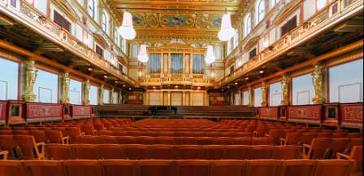




|
akutek.info |
|
The www center for search, research and free sharing in acoustics |
|
Essay By Magne Skålevik Our most highly rated performance spaces so far are more or less a result of a process that best can be described as Natural Selection, or Survival of the Fittest. The ancient amphitheatre, the baroque horse-shoe theatre and the shoebox (what is it with shoes?) concert hall turned out to be successful, so they were copied and maintained, and copied again. As far as the theatre-halls are concerned, the Origin of the Species is obvious: A good performance would spontaneously attract spectators in a circle. In an outer circle people will need to look between those in the inner circle—the origin of the staggered seating. The next circles would have to stand higher—the origin of the raked seating arrangement. The direction of the play would make one half of the circle more popular than the other—the origin of the semi-circular seating arrangement. What else could be the result, than the ancient Greek classical theatre? A court yard would be perfect for a medieval performance. People could just hang out of the windows, and they would have perfect sight-lines, and due to the early reflections from facing walls at all sides, sound level and definition would be adequate. Now, breed some ancient theatre with some court yard, put a roof on top to protect audience from rain, wind and snow, and you get most of the historically successful theatres in Europe. Who could afford having a chamber orchestra? Those who have a lot of money, big houses with big chambers, of course. Kings with castles, for example. Haydn happened to write a symphony, and people liked it. Many symphonies were written, symphonies stimulated the orchestras to grow in size. Big orchestras needed space and bigger orchestras could fill bigger halls with sound, and bigger orchestras were perfect for playing romantic music. In the romantic period, there were rectangular halls of adequate size. Reinforced concrete beams and steel trusses were rare in the 19th century, so wide, free roof spans was not an obvious option. Therefore, these halls were rectangular and narrow. To accommodate a large audience, the longer halls were preferred. Therefore, narrow and long halls became naturally attractive. The double-cube, or the shoe-box, was born. In the symbiosis between the shoe-box hall acoustics, and the symphony orchestra, classical and romantic music was further developed. People liked it, and the best halls were preserved. The Musikverein in Vienna, finished in 1870, is an example of a hall that was fit enough to survive, being 19 m wide, 18 m high, and in total 49 m long (actually longer than a double cube of 19*19*38). |
|
The Origin of the (performance) Spaces |

|
Goldener Saal, Musikverein, Vienna (Source: wikipedia.org) |
|
Breeding, mutations, and genetic engineering The more deterministic approach of hall design was not always as successful as the natural selection process as described above. Though preferred halls are likely to be preserved, it is not obvious that they will be copied. In terms of the evolution metaphor— the shoe-box may not be allowed to breed. Neither was it obvious that the actual performance space had anything to do with the fact that people liked the music being played. It might as well be due to the beautiful works of the composers and the good orchestras. In the case of Gewandhaus (Leipzig) and Musikverein (Vienna), there have been orchestras with long, proud traditions and high quality standards. Architectural reasons had led to the existence of the halls where symphony orchestras attracted large audiences over many years, why should not architectural reasons lead to more success? However, there could be need for some genetic engineering (or manipulation). During the romantic period, as the composers made larger works, the symphony orchestras tended to grow out of their shoe-boxes. Unsuccessful breeding In this playing with words, we shall keep in mind that an unsuccessful concert hall species could well be appreciated, popular, preferred and celebrated. However, we observe that some concert hall mutations have lack of generic success, and we point at some possible explanations. In the 19th century, someone suggested that a concert hall enclosure should resonate with the music, like the body of a violin resonates with its strings. One have to admit that this “learn-from-nature” concept is quite intriguing. However, in our belated wisdom we now understand that while such vibrations in the body of the violin promotes the radiation of sound, they are in the vast surface areas of a concert hall enclosure associated with sound energy being converted into thermal energy. Another dead end in genetic engineering is the search for The One Great Acoustic that could be acoustically perfect for both speech and music. This approach would inevitably lead to clarity that is good for speech but too much for music, and vice versa. The sound reflector and sound directive surfaces was one of the early remedies that man learned to use in acoustic control. Any engineer blinded by his knowledge of such powerful acoustic elements would be tempted to use it to direct 1st order reflections into the audience. In most cases, one would end up with parabolic sections, or even worse— if not even distribution is considered —with elliptic sections. Such geometries can be seen in the envelopes formed by reflector array systems extending from stage and into the auditorium in many halls from second half of the 20th century, but also in sections of the ceiling surfaces of concert halls from the first half of the same century. The Art Deco style Salle Pleyel in Paris is an example of the latter. And where Form followed Function, inclining side walls followed the structure - not the acoustic needs. The fan-shaped concert hall is what you get if you crossbreed an ancient theatre with a classical shoe-box hall. It has common features with the lecture hall—which is in it self alarming given knowledge of today. The main asset of the fan shaped hall is the orientation of the audience towards the stage, combined with improved sightlines due to a steeper rake and higher seating capacity due to the wide rear part of the hall, as compared to the classical shoe-box. Reinforced concrete beams of the 20th century had made it affordable to span the roof over the fan without columns, so the fan-shaped hall idea could be nourished by architects. But is it Fit enough for Survival? In the middle of the 20th century, Beranek pointed at the fact that preferred halls had a rather short (less than 30 ms) time gap between the direct sound and the first reflection, the so-called initial time-delay gap ITDG. He suggested that ITDG is associated with the sense of intimacy in the hall. In fan-shaped and other wide halls, the ITDG’s were inherently rather long. Since the late 1950’s, the lack of early reflections from nearby walls was commonly compensated by introducing ceiling reflectors, or just lower ceilings. The earlier reflections from above did no doubt reduce the ITDG in wide halls to a more preferable value, but there was surprisingly little enthusiasm. Something was still missing, or maybe even become worse. What is this something? One had to wait some years for the answer to this question. In the mean time, the fan shaped and wide halls were allowed to breed. Imagine a roof on top of an ancient arena, and you see Albert Hall, London (19th century). A dome could be able to span over a wide space, but a concave ceiling would not be found in the recipe of a successful concert hall. Several innovative remedies were tested out from the early 1900’s, but the patient did not get much better until the flying saucers arrived half a century later, improving the IDTG as well as relieving the bad reflections from above. The atmosphere of a large space, gathering thousands of people under a dome, should not be underestimated. As an individual the hall might survive for centuries. However, if being unattractive for listening to music, a hall will not be a natural selection for the audience. Hence it can not survive as a concert hall species. The old arena concept— having the performance surrounded by audience and spectators led to the conception of a whole branch of wide halls, in the period from the 1950’s to the 1980’s. Bringing more people closer to the orchestra, or bringing the orchestra out to the audience, is a good idea as far as room acoustics are NOT being concerned. Which has often been the case. Surprisingly, since one might expect acoustics to be the main concern whenever a concert hall was being planned, especially after so many reports of acoustically disabled halls being born. Was it due to lack of acoustical knowledge, lack of consensus among acousticians, fumbling with test-tubes in the laboratory? Or was the architect just being too dominant? One should keep in mind the obvious conflict of interests here: While good acoustics could safely be achieved by cloning an acoustical success, perhaps with some controlled modifications, the architect competition often calls for something completely new—preferably a hall that is different from any hall having existed before. This leaves the acoustician with the exciting challenge to find the measurable reason for acoustical success. Could it be achieved inside different architecture? Some acousticians welcomed the challenge and some builders accepted the risk. In the age of Sabine, by the beginning of the 1900’s, the reverberation time seemed to be the one and only ingredient in the recipe. Today, there are more room acoustical parameters suggested than the acoustician can use at once. Among all the failed experiments, there were some honourable exceptions. Honourable exceptions Post-war building led to acoustical disasters in London and New York. In Berlin, however, a miracle occurred. While most other arena-like halls have failed, The Berlin Philharmonie became the forefather of a new species of concert halls—the vineyard hall. Apart from the slightly smaller size success in Cardiff, UK, it happened to become big in Japan. If not among the very top rated halls, they are frequently mentioned among the top 10 . From Japan, seeds have flown back to Europe lately, as can be seen in Helsinki and Copenhagen. And even to LA. (Suntory Hall, Tokyo) In Berlin the architect Sharoun was guided by the acoustician Cremer’s knowledge of the importance of early reflections. As mentioned before, first order reflections had received much attention in the first half of the 20th century, and in particular, the ITDG should not be too long. This criteria was met in the vineyard halls as the subdivisions of the seating areas provided all seats with nearby reflecting surfaces. Since the interest in early reflections inevitably introduced the problem of possibly too much or too little early energy, there was a need for objective measures. Following this vacuum, three clarity parameters popped up. Deutlichkeit ,or Definition (D), is a “the more the better” parameter designed for speech, since it measures the early (50ms) energy related to the total energy. More adequate for music, the musical clarity C80 describes the balance between early (0-80ms) energy related to the late energy. Too low value of C80 would indicate loss of articulation and detail in the music, while a too high C80 would indicate a lack of reverberant qualities like temporal smoothness, etc. Later, the center time Tc —the time delay of the moment of energy gravity— was introduced as an alternative way to describe clarity without abrupt time limits like 50ms or 80ms. If reverberation time RT historically was the first room acoustical parameter for concert halls, the clarity parameters would be the second. Proper clarity could be achieved in several ways: By early reflections from side walls or balcony cornices in narrow shoe-box halls, from nearby fascias of vineyard halls, or from canopy arrays of wide fan-shaped halls. It was possible to achieve the same ITDG in all three, and clarity would not distinguish between directions from which the early reflections arrived. Still, listeners would rate these different halls differently, and in the early 1960’s the reason for this was not clear. Remember, this was the in the monaural age, but binaural hearing lingered about in laboratories, scientific conferences and in journals. The popular stereophonic revolution was just around the corner, and it turned out to be more than just twice the fun (The first stereo records from The Beatles was just a pair of mono tracks), it revealed a new dimension in musical reproduction. It was about time for Marshall to point at the significance of lateral reflections, which was demonstrated in an arena-like hall on the opposite side of the globe from Berlin, in Christchurch, New Zealand. The success was repeated in Wellington. Since then it was evident that it makes a difference whether the early reflections arrives from the sides or from some other direction. This room acoustical property could be measured by the Early Lateral Fraction (LF80). Success criteria During the period from 1900 to the 1970’s, the number of suggested important objective room acoustical success criteria for concert halls had grown from just one—the reverberation time—to quite a lot: Reverberation time (T30), initial time delay gap (ITDG), Clarity C80, early decay time (EDT), centre time Tc, Early Lateral Fraction (LF80) and the 1-IACC. They formed a set that are not statistically independent of each other, so there have been discussions for decades over which ones to keep and which ones to get rid of. However, there seemed to be consensus that listeners prefer acoustics where the values of the parameters were within certain limits. With this knowledge, it was no longer sufficient to achieve T30 close to 2 seconds. The ITDG should be shorter than 30ms, the C80 not too far from 0dB, and LF80 preferably between 0.15 and 0.35. It was no longer a mystery why the shoe-box halls were so highly rated. In a sense, the genetic code was cracked, but there was still more to reveal. Successful breeding and dangers Around 1900, a seed was carried over the Atlantic Ocean, from Leipzig to Boston. Sabine suggested the reverberation time as the success criteria, but manipulated the absorption genes. Demand for more comfort called for more room per seat than in the Leipzig Gewandhaus, and it was at the time not known that this would increase the absorption per seat. Hence, the reverberation time became lower than he predicted. Boston Symphony Hall is still rated among the very best concert halls. The shoe-box shape and other similarities with the Gewandhaus assured that the acoustics were taken care of, and the reverberation time is within preferred limits. It took half a century to clarify the misunderstanding of calculating absorption per seat, rather than absorption per occupied area. In an age with demand for more seats combined with more comfort (more space and thicker upholstering), this inevitably led to a generation of halls having too short reverberation times. Non-rectangular geometries tend to direct more of the reverberant sound into the audience, making the absorption even more efficient and the reverberation times even lower. One can only speculate about what these misunderstandings did to confidence in acousticians, not to mention to the acousticians’ confidence in themselves. Anyway - concert hall acoustics was a very young science at the time, and even if they had achieved the reverberation times they were aiming for, it would not have solved all the problems of the halls from that period. Sabine is still highly regarded as a pioneer, and the reverberation time criterion is no less important today than it was a hundred years ago. Armed to their teeth with room acoustical parameters, and full of self-confidence, by the 1980’s the acousticians were ready to challenge architects and clients with more insight: It is not a coincidence that shoe-box halls have the preferred acoustics for symphonic music. In fact, one could prove that it is all about science. The architects as one can understand were not happy about this conclusion, but after a century when acoustic failure had become a rule rather than an exception, some clients were ready to accept that it their hall was not going to be very innovative in shape if excellent acoustics was to be guaranteed (Birmingham). Johnson was the man who regained the power of the acoustician in the planning of concert halls. And, as also frequently happens with test tube conceptions, the modern shoe-boxes came in triplets or even more. They had many common features. Not all the common features can be justified by acoustics, and this concert hall species may be threatened by inbreeding. There was always the danger when architects fell in love with their own concepts, but no less if the acoustician does so. Future breeding By the beginning of the new millennium, it has been proven that it is possible to plan for good concert hall acoustics. What remains is to prove that this can be achieved even with great freedom for the architects, not only by genetic modification of shoe-boxes, as long as the acoustic success criteria are satisfied. While good acoustics can be predicted, excellent acoustics still seems unpredictable. The species will continue to evolve in interaction with music, directors and composers. This far we have yet to hear a genre like Reverberation Chamber Music, or a musical work for symphony orchestra and a Double Slope Decay. |

|
on site |